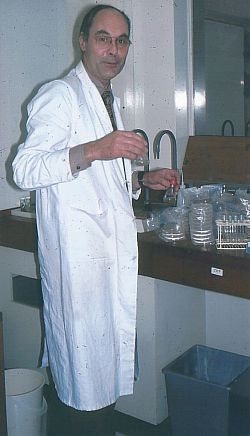Obituary: John Postgate
Responding to the death of Professor John R. Postgate FRS at the age of 92 on 22 October, Professor Hermann Bothe of Cologne University aptly noted: “We have lost one of the greatest microbiologists of our generation.”
 Professor John Postgate
Professor John Postgate
From 1965 until his retirement in 1987, John was based at the Agricultural Research Council’s Unit of Nitrogen Fixation on the Sussex campus and was also a Professor of Microbiology in the School of Biology.
In the 1940s John had gained a chemistry degree at Oxford, followed by a postgraduate degree in microbial physiology.
He then became senior research scientist at the Laboratory of the Government Chemist and then in the Microbiological Research Department at Porton Down military science park in Wiltshire.
John’s connection with Sussex stemmed from the foundation in 1963, with Professor Joseph Chatt FRS, of the Unit of Nitrogen Fixation, set up by the ARC to determine how micro-organisms can convert aerial nitrogen into ammonia under ambient conditions, whereas, industrially, high temperatures and pressures and catalysts are employed.
Given his academic qualifications in both chemistry and microbial physiology, John was eminently qualified to direct the wide approach demanded of an interdisciplinary research group of chemists and biologists, such as the Unit of Nitrogen Fixation.
By 1965 the Unit was housed at Sussex in the then Chemistry building, now Chichester 1. In 1968 it moved to an adjacent purpose-built home, now the Arundel building. Finally, in 1995, the Unit moved to the John Innes Centre in Norwich.
John directed first the biological work and later the whole Unit. He urged and cajoled the researchers to co-operate and to co-ordinate their work, but he never ordered them to do so.
Many postgraduates benefited from John's rigorous and wise supervision in his role as Professor of Microbiology in the School of Biology at Sussex, and two of these students - Sir Howard Dalton FRS and Professor Ray Dixon FRS - became distinguished in their own right.
The close-knit Unit of Nitrogen Fixation became internationally pre-eminent. The work of Ray Dixon on transferring the nitrogen fixation genes between bacteria resulted in the formation of a microbial genetics group.
Finally the Unit consisted of 45 scientists plus visiting scientists, and employed 80 people. However, John never ceased to do his own research in the laboratory, but always co-operated with his colleagues.
John was also active in the Society of Microbiology, as Council member and President, and was respected editor of the Society’s journal.
His clarity of writing is evident in the popular book Microbes and Man, published in 1969, which is still in print after four editions and has been translated into nine languages.
More recently, in 2013 he published his autobiography, Microbes, Music and Me: A life in sciences.
His keen interest in jazz yielded articles about musicians and jazz topics, and friendships with like-minded enthusiasts. He played the cornet, in various bands, including the University jazz group Sussex Trugs.
Susan Hill
